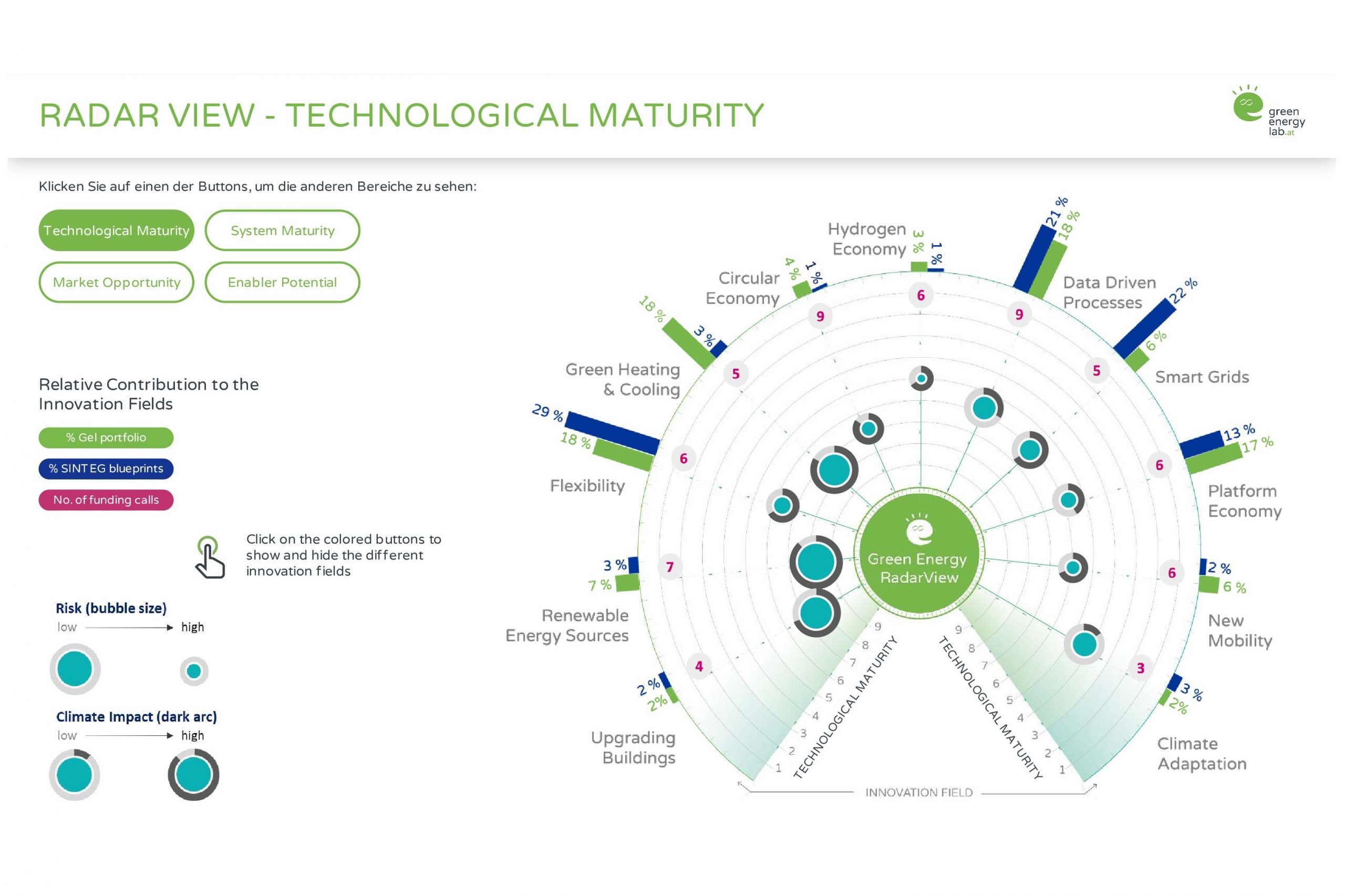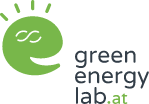Green Energy Lab visualizes the future of energy
The new interactive "RadarView" enables innovation fields to be recognized more quickly and their potential to be exploited.

Radar View: Technological Maturity
22 March 2023 – The switch to sustainable and future-proof energy solutions is a key factor in the fight against climate change. In collaboration with stakeholders and experts, the Green Energy Lab innovation laboratory has developed an interactive visualization that analyses, evaluates and clearly presents technology trends in the energy sector. This “RadarView” is the core of the “Green Energy Foresight”. It helps identify technologies that will enable Austria to make our energy supply future-proof as quickly and sustainably as possible. The good news is that the key technologies for this have already been developed – now they need to be used consistently.
The Green Energy Lab innovation laboratory is developing a new visualization to identify promising starting points for change in the energy sector. Using modern trend research methods, “RadarView” identified eleven areas of innovation that could have a very rapid positive impact on our climate and energy future.
The fields of innovation and their technologies are evaluated according to six criteria: the maturity of the individual technology, the system maturity of the technology, the market opportunities and the potential of the technology to enable change. In addition, the risks as well as the direct impact that the technologies have on climate change mitigation are assessed.
Mathias SchafferCEO of Green Energy Lab: “The key technologies for the energy transition already exist. Now they need to be implemented quickly and consistently. With our “RadarView”, we want to show companies which current and future trends in the energy sector can contribute to a sustainable energy system in Austria.”
A market-ready technology mix for the energy transition
“It is clear that no single technology will bring the breakthrough. It will take the interaction of several key technologies to cover as many areas as possible,” says Schaffer.
The system maturity of these technologies is an important criterion for determining how far the integration of the technology into the existing energy system has already progressed. By focusing on technologies with a high degree of system maturity, the aim is to achieve a rapid and noticeable effect.
“The marketability of the technologies used is essential for long-term results. A sustainable energy transition cannot be financed by subsidies in the long term. It requires business models that trigger meaningful and sustainable changes in the energy sector,” concludes the Chairman of the Green Energy Lab.
Smart buildings and artificial intelligence for the sustainable energy transition
The identified fields of innovation show just how important the interaction between the various technologies is. One of these concerns the building sector: in future, houses will actively participate in the energy system. There is already a whole range of smart solutions for new buildings. In order to make all buildings climate-ready, approaches must be developed that can also be applied to existing buildings.
Christian KurzR&D Manager at Green Energy Lab: “The building sector has huge potential: with the help of digital energy measuring devices, intelligent control systems and innovative construction methods, the buildings of the future will be able to exchange information with the energy grid in advance and serve as decentralized energy buffers.”
Regional energy supply plays a key role, not least due to current geopolitical developments. The use of waste heat sources and the development of scalable seasonal energy storage systems form the innovation field of green heating and cooling. “Research and demonstration projects on this topic are a focus of Green Energy Lab. The knowledge gained from these projects flows back into new projects,” says Short.
The To and fro for the reduction of CO₂-emissions is the expansion of renewable energy sources. In this field of innovation new legal framework conditions also play a major role. However, the flexibility of the energy systems – or more precisely the electricity grids – is also considered to be just as relevant. Research into the improved use of renewable energy sources such as wind energy and photovoltaics are already part of Green Energy Lab’s portfolio.
Another clearly recognizable trend is the circular economy: the focus is on “waste as a resource”. Through recycling, a large proportion of the CO₂ be avoided. It also reduces dependence on raw material imports. However, the innovation field of the circular economy is more than just recycling: the active binding of CO₂ in the atmosphere or the generation of electricity by microbes are parts of the field that can still be explored.
Andrea Edelmann, board member of the Green Energy Lab: “The circular economy in the field of renewable energy still has huge potential and is a more than important idea in resource-poor Europe. The opportunities for innovation in areas such as CO₂-circular economy are enormous. The use of existing infrastructure also helps to conserve resources.”
Enabler technologies are required for all of the aforementioned fields of innovation. Thanks to advances in digitalization and the use of data-based processes, these highly complex systems can be made more efficient. The networking of all system elements (e.g. “Internet of Things”), the innovative handling of large amounts of data (“big data”) and the use of learning systems (“machine learning” and artificial intelligence) play a key role here.
Green Energy Foresight
“RadarView” emerged from the Green Energy Lab innovation laboratory. For four years now, Green Energy Lab has provided a platform for pooling and exchanging know-how in the energy sector. Together, energy trends are analyzed, subjected to a reality and relevance check and their impact on climate change assessed and updated on an ongoing basis. “RadarView” sees itself as a visualization of the “Forsighting Journey” and is designed to be interactive. Each innovation field serves as a starting point for more in-depth research. The RadarView also reveals topics such as the existing buildings sector or the circular economy, which have a particularly strong leverage effect for the energy transition and should be taken into account accordingly in the orientation of research programs.
Here you will find a report about Green Energy Foresight.
